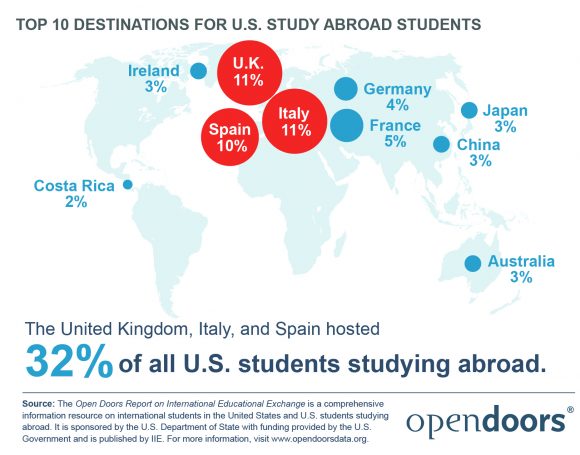Chapman Increases Global Education Rankings Trends in education abroad destinations and student profile
November 23, 2020
The 2020 Open Doors Report on International Educational Exchange, released November 16 by the Institute of International Education (IIE), provides a critical baseline on the state of international educational exchange prior to the impacts of the COVID-19 pandemic. The report highlights that during the 2018/2019 academic year, 347,099 U.S. students studied abroad for academic credit, a 1.6% increase over the previous year. Documenting ten consecutive years of growth, the 2020 Open Doors report provides a benchmark, indicating strong interest in study abroad programs.
Following trends, global education participation and rankings for Chapman students also increased in 2018/19: 46.1% of undergraduate Chapman students participate in an international program before graduating, ranking #35 compared to other Doctoral Institutions for undergraduate participation. Chapman ranks at #106 for total number of students abroad (with 774 undergraduate and graduate students) compared to all reporting institutions, up from #127 in the previous year.
European countries (including the United Kingdom) remain the most popular destination for U.S. students. Latin America and the Caribbean remains the second most popular region for study abroad, while Asia, the third most popular region, increased by 6%, driven by a 16% increase in study abroad to South Korea and a 5% increase in study abroad to Japan.
Host Regions of all U.S. Study Abroad students 2018/19:

Top 10 Destinations for all U.S. Study Abroad students 2018/19:

Top 10 Destinations for Chapman Study Abroad students 2018/19:

Americans who study abroad are increasingly diverse, with 31% percent of U.S. students who studied abroad in 2018/19 identifying as racial or ethnic minorities. While this is an improvement from the 15% representation 20 years ago, it remains below minority participation in U.S. higher education today (45%). The Center for Global Education created a brochure for Black, Indigenous, and Students of Color Abroad brochure for considerations when selecting a program, student testimonials, tips for students, and to reflect on how studying abroad can shape your identity.
Race/Ethnicity of all U.S. Study Abroad students 2018/19:

The number of students with disabilities who are studying abroad also increased in 2018/19 at 10.5% of all students abroad (+1.3%) with mental disabilities, learning disabilities, and chronic health disorders accounting for 85% of all disabilities represented. The Center for Global Education created a Students with Disabilities Abroad brochure for considerations when selecting a program, student testimonials, tips for students, and to reflect on how studying abroad can shape your identity.
The Center for Global Education offers around 30 short-term Travel Courses, 90 semester abroad programs, and 7 summer international internship opportunities each year. Chapman students can use most of their federal, state, and institutional aid on 90% of semester abroad programs and earn academic credit to fulfill their Chapman requirements. External scholarships are available including the Gilman Scholarship.
About Open Doors
Open Doors is a comprehensive information resource for international students studying at higher education institutions in the United States, and U.S. students studying abroad for academic credit at their home colleges or universities. Open Doors also reports on the number of international scholars at U.S. universities and international students enrolled in pre-academic Intensive English Programs. Further details on the 2020 Open Doors findings are on the Open Doors website. For more data, infographics and resources visit OpenDoors.org.


